How To Transform Fingerpicking Patterns Into Incredible Sounding Music
by Simon Candy
 In any area of guitar playing a little technique can go a long way if you know how to apply it creatively.
In any area of guitar playing a little technique can go a long way if you know how to apply it creatively.
In this article, I am going to present to you several commonly used fingerpicking patterns for guitar.
The patterns themselves are not really that important, at least not in the context of this article. What is of utmost importance, however, and the whole focus of this lesson, is the creative application of these fingerpicking patterns (ie. actually to create music). Yes, having a variety of fingerpicking patterns from which to fingerpick your guitar is essential.
However, without the ability to creatively apply fingerpicking techniques and patterns to produce music, it will be futile. In today's lesson, I will show you a single chord progression and several fingerpicking patterns. We will then explore creative ways to apply these patterns to create amazing-sounding music from just a few basic ideas.
Common Fingerpicking Patterns For Guitar
The following are 3 common approaches to fingerpicking guitar. Each on its own will do little for your guitar playing. The key is in the creative application of these patterns which we will be doing very shortly.
• The Travis Picking Pattern
The following is perhaps the most common and useful fingerpicking pattern that you are likely to come across. It is known as the travis picking pattern.
This pattern consists of your thumb playing a steady bass line on the lower 3 strings of the guitar, while your fingers play combinations of the higher 3 strings on and in between these bass notes.
Here is a basic travis picking pattern on the open strings of the guitar:

• The Banjo Roll Pattern
Next, we have a forward banjo roll which is a common pattern for fingerpicking guitar:

These banjo rolls can be incorporated into your guitar playing in various ways, producing amazing sounds.
• The Open String Pattern
This third pattern for fingerpicking your guitar is a little more generic. It doesn’t really have a name commonly associated with it. However you will see shortly how I apply it to create some really cool solo fingerpicking lines involving open strings.
Here it is ascending:

And here it is descending:

Fingerpicking Chord Progression
To demonstrate the versatility of our fingerpicking patterns, I will use the same chord progression for the application of each pattern. This helps emphasise the mileage we can get out of each pattern across a single chord progression.
Here is the chord progression to which we will apply our fingerpicking patterns:
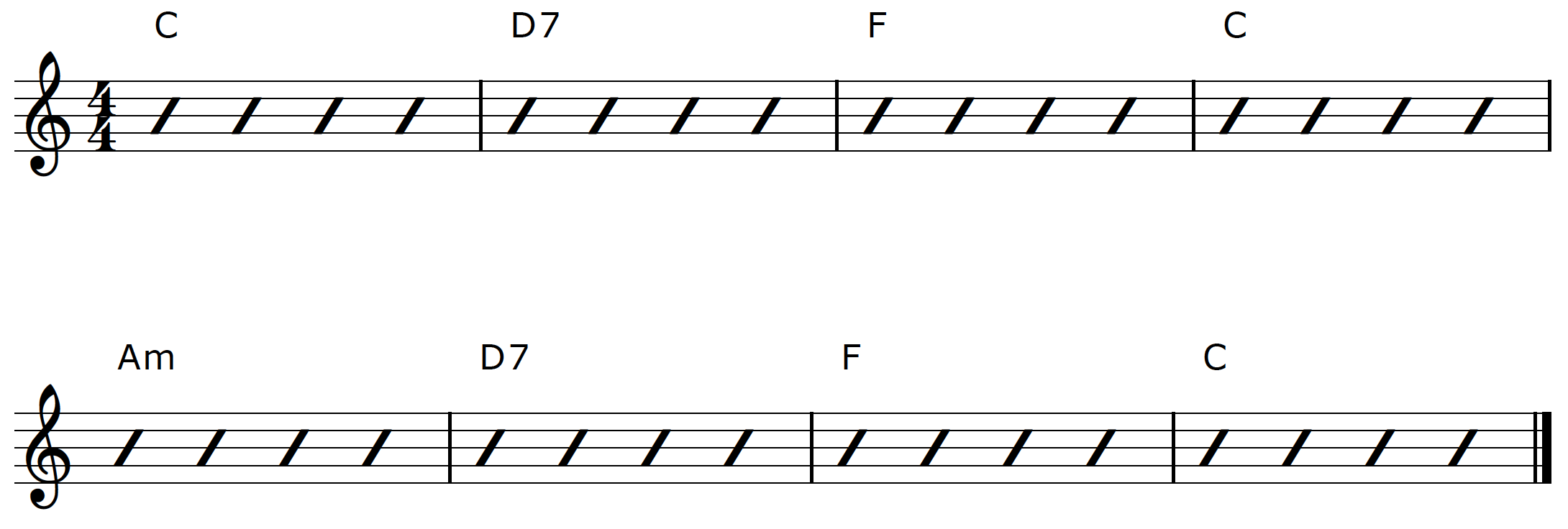
Creative Fingerpicking Application 1: The Travis Picking Pattern
Below is an example of applying the travis picking pattern to our progression:
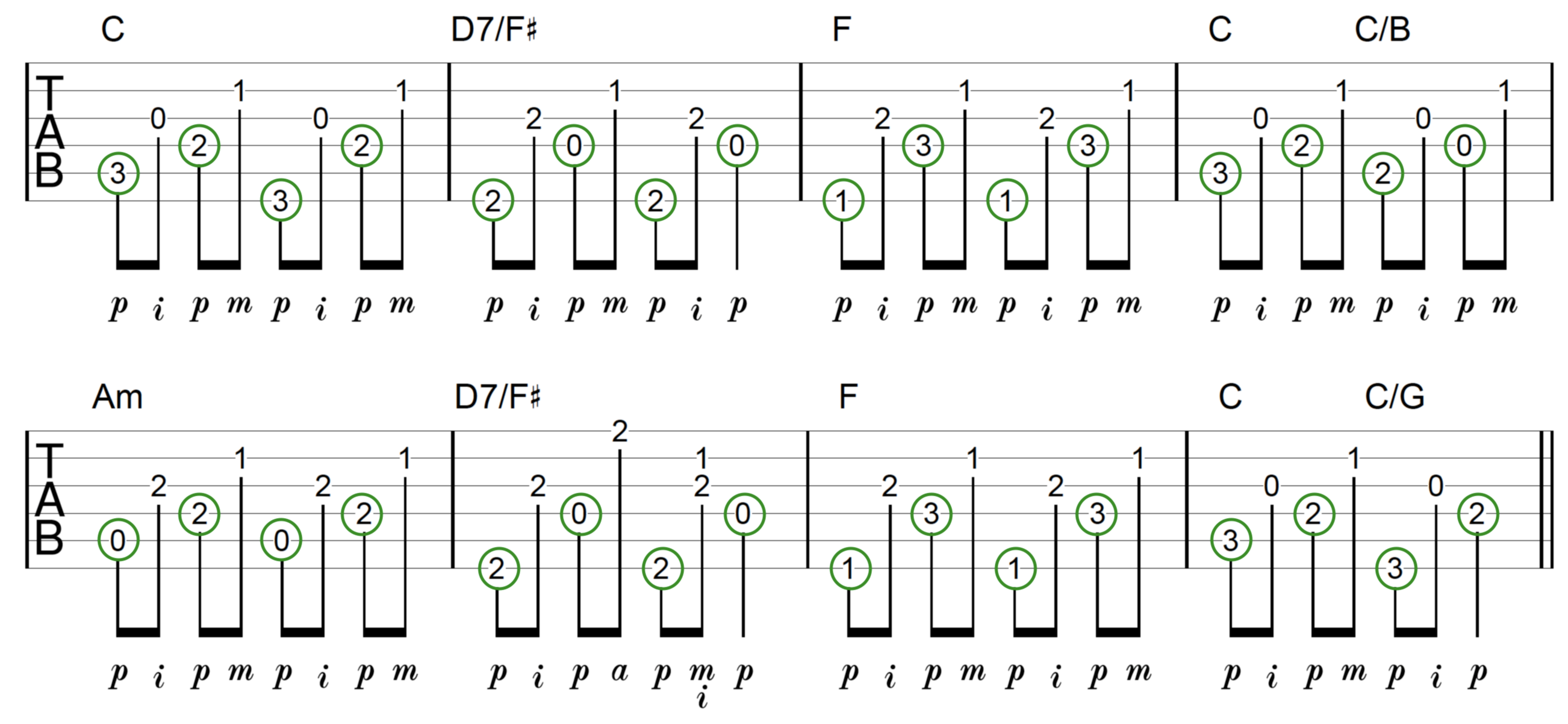
Notice how the bass note of each chord always falls on the beat.
I have highlighted these notes so you can see this more clearly.
The bass is at the foundation of the travis picking pattern.
To learn more about the travis picking pattern check out the video below.
In this lesson, I break the travis picking pattern down into great detail and show you how you can make it part of your guitar playing:
Creative Fingerpicking Application 2: The Banjo Roll Pattern
So how can we apply our banjo roll fingerpicking pattern to this progression?
The answer is many ways.
Here is one example:
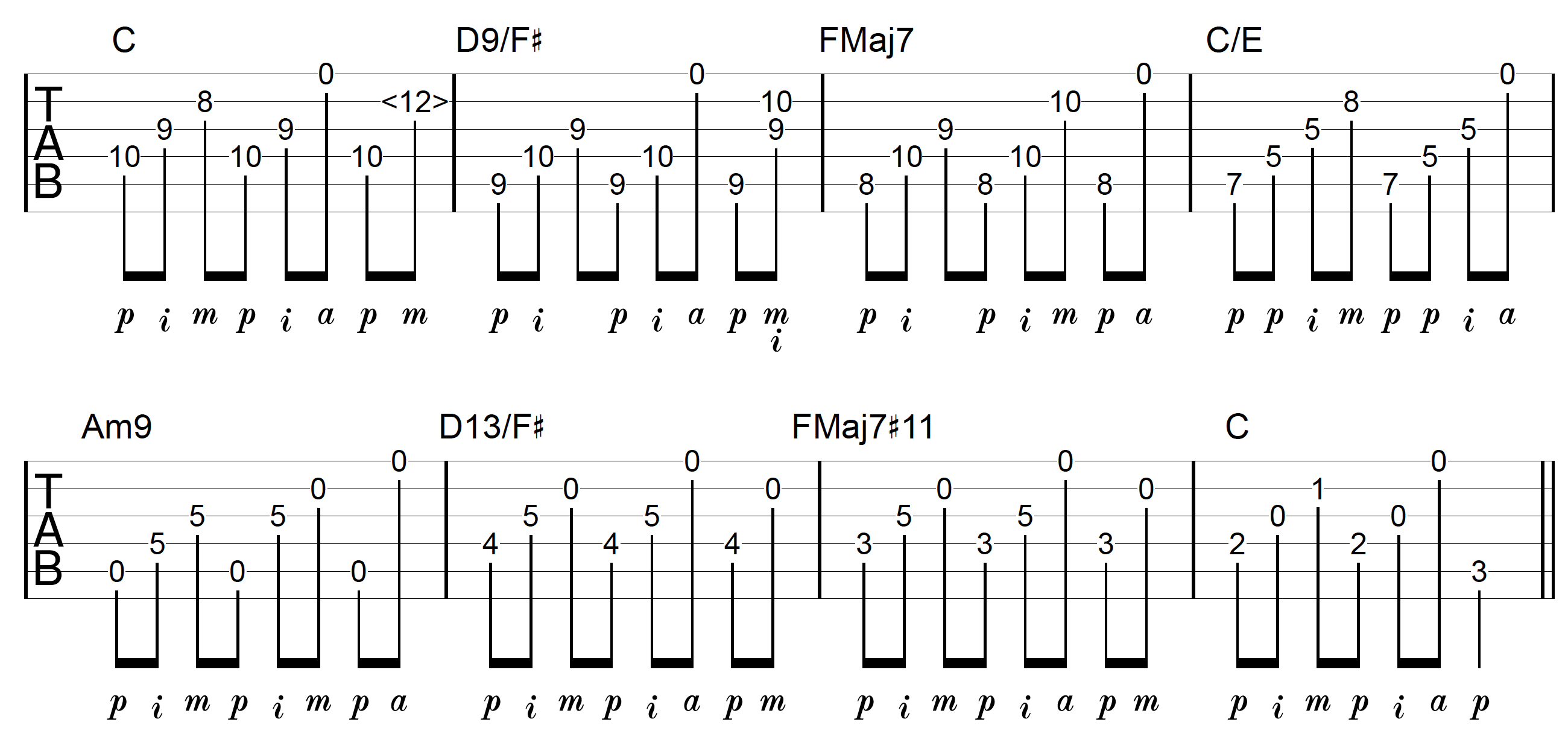
Not only are we applying a different fingerpicking pattern to our progression, but we are also using different chord shapes. Learning multiple ways to play a chord progression on the guitar with various shapes allows for even more creative fingerpicking possibilities.
You will notice I have had to adapt the banjo roll pattern to fit some of the chords I am using.
The lowest note of each chord determines where the pattern starts.
For example, I begin the pattern from the 5th string for the D9/F#, FMaj7, and Am9 chords, as each of these chords starts from this string.
You may also notice I have made minor variations to the banjo roll pattern itself regarding the order of the strings.
The overall sound is quite different to our travis picking approach but sounds just as good.
Checkout the video below to discover how to transform a chord progression using open strings and banjo rolls on guitar:
Creative Fingerpicking Application 3: The Open String Pattern
This third application of our fingerpicking skills is quite different to our first two approaches. For a start we are totally abandoning our chords and instead, creating a very cool open string fingerpicking riff that implies the harmony of our progression.
Check it out:
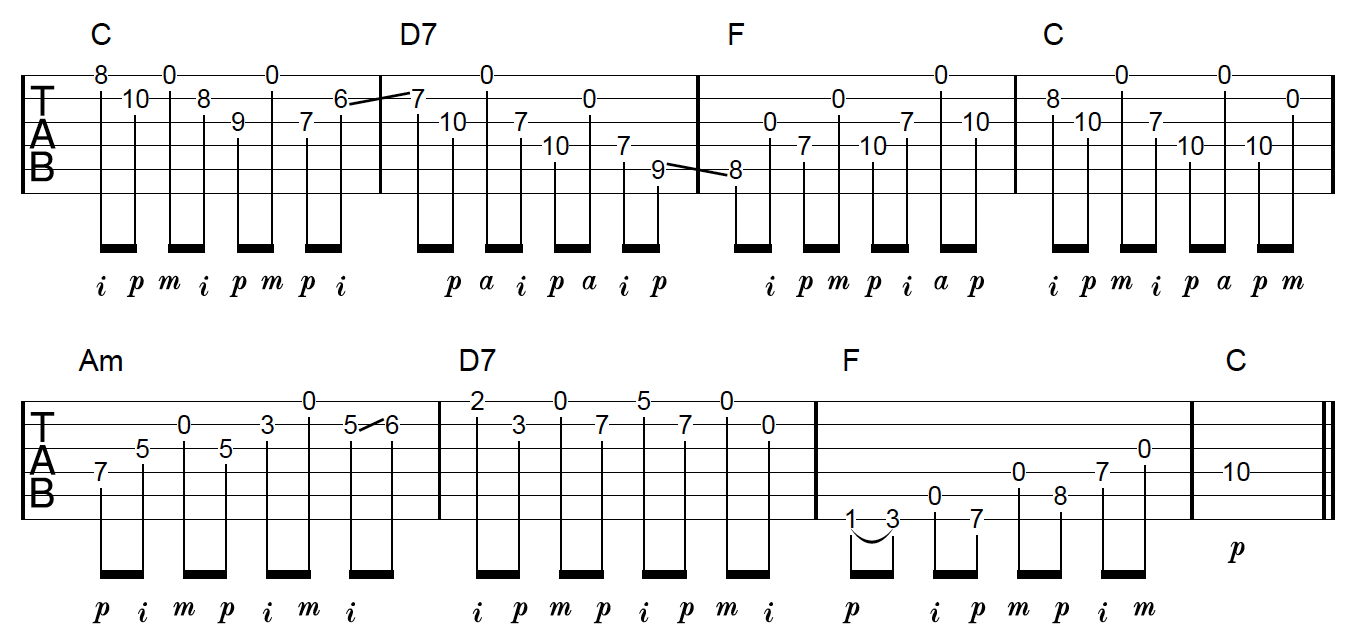
Notice that even though there are no chords played in this example, you can still hear the harmony of the progression. This is because I am targeting the tones of each chord as they occur in the progression. As was the case with our forward banjo roll, I am not exclusively using the ascending and descending open string patterns throughout this example, although they do feature heavily.
For more ways to create unique sounding solo lines using open strings check out the video below.
In this lesson, you learn how to create great sounding solos using open strings and the pentatonic scale:
Combining Approaches Into A Creative Fingerpicking Etude
Let me present to you here a short etude that combines all 3 fingerpicking approaches from above. I think when you hear them all together, back to back, you will hear just how much variety in sound you can bring to a single chord progression with your fingerpicking skills:

What I want you to see here is the potential of what just a handful of fingerpicking patterns can bring to a single chord progression, and that it’s not how many fingerpicking patterns you know, or how great your technique is, but how well you can apply all this stuff to create actual music!
I also want to emphasize the importance of your fretting hand in showcasing your fingerpicking creativity, including chord variety, harmonization, and melodies.
Learn how to truly master your fingerpicking on guitar once and for all, and gain the freedom to play whatever you want.
The 7 Step Guitar Riff Workout Part 2 - How To Improve Your Guitar Solo And Improvisation Skills
by Simon Candy
 In part 1 of this lesson I took you through the first 3 steps of my 7 step guitar riff workout lesson.
In part 1 of this lesson I took you through the first 3 steps of my 7 step guitar riff workout lesson.
Today we will complete the workout with the final 4 steps required to truly take the riffs you learn and have them become part of your guitar playing where you can draw upon them time and time again to create incredible music.
As you started to learn in part 1 of this lesson, there is much more than meets the eye regarding getting riffs into your guitar playing from which to then create and improvise your own music.
It requires a workout of sorts to achieve this, hence the 7 Step Guitar Riff Workout!
So let’s now continue that workout to more easily enable you to create music with the riffs you learn on your guitar.
4. Move The Riff
 A great way to open up the fretboard to understand and visualise it on a whole new level is to take a riff and learn to play it in multiple positions.
A great way to open up the fretboard to understand and visualise it on a whole new level is to take a riff and learn to play it in multiple positions.
Why bother doing this?
Many reasons.
As already stated, being able to visualise and play a riff all over the neck of your guitar will deepen your understanding of the relationships the fretboard holds.
Playing riffs in multiple positions will result in you phrasing the riff differently.
This is because the notes of the riff tend to fall under your fingers differently in some positions compared to others.
Additionally, playing the riff in different positions will provide you with more opportunities to incorporate it into your playing, as there will be a version of it available no matter where you are on the fretboard.
Let’s apply this approach to our riff.
• Example 1
We will start by moving our riff to the higher octave within pattern 1 pentatonic scale, the original scale in which we created the riff:

Notice that moving the riff causes the notes to fall under our fingers differently.
When adding slides, hammer-ons, and pull-offs (which we will be doing shortly), you will have different phrasing possibilities that can make your riffs sound more musical and interesting.
• Example 2
In this example I am moving the riff back to the original octave, this time within pattern 5 pentatonic scale:

• Example 3
Next, let’s move our riff to the top of pentatonic scale pattern 2:

By moving the riff to the top of pattern 2 we are presented with a third possibility regarding how the notes fall under our fingers.
• Example 4
Here I will move our riff to the lower octave of pentatonic pattern 2:

With pattern 3, the riff remains in the same position as it did in pattern 1 before being moved.
• Example 5
Now let’s move the riff to the lower octave of pattern 3:

Notice with pattern 3 the riff falls under our fingers the same as it did in the original position within pattern 1, before we started moving it around the fretboard.
• Example 6
Here is our riff venturing into pattern 4 of the pentatonic scale:

This pattern throws up yet another possibility regarding how the notes of our riff fall under the fingers.
• Example 7
When placed in the lower octave of pattern 4 the riff once again falls under the fingers as it did in examples 1, 2, and 4:

• Example 8
Finally, let’s move our riff into pattern 5 of the pentatonic scale:

It is highly beneficial to learn the riff in each position mentioned above and practice switching between them at regular intervals. Doing so will improve your ability to shift between the different pentatonic scales and work within each shape rather than just on it.
5. Sing The Riff
 Developing your ear and the ability to play what you hear in your head on the guitar is an essential skill.
Developing your ear and the ability to play what you hear in your head on the guitar is an essential skill.
One great way to achieve this is by using your voice to sing the notes of the riff as you play them.
This technique can be applied to anything you play on guitar. You don't have to do it every time, but practising it regularly will help connect your voice to the guitar.
It's not about singing perfectly. Even if you can't carry a tune, this technique is still beneficial for you. It is all about developing the ability to play melodically on the guitar.
By pitching along with the riff as you play, you are essentially ingraining it into your ear, making it easier to recall when needed.
When first learning a riff, your fingers play a significant role in guiding your voice when you're singing.
They help you find the right notes.
However, with time and practice, this process changes, and your singing starts to guide your fingers.
This means that your playing will become more melodic and musical.
When you find yourself struggling to come up with new ideas while improvising, using your voice can help. It will enable you to play more melodically and naturally, and you'll be able to express what you're feeling more effectively.
Be patient with this as it may take a little getting used to, but with practice, you’ll start to resonate more and more with the riffs you play on guitar.
To learn more about singing along with your playing check out the video below:
6. Vary The Riff
 Taking the riffs you learn on guitar and creating variations of them is a great way to develop your improvisational skills. When soloing on guitar the riffs you play should relate to one another. They should tell a story. Playing one random riff after another, even in the same key, is called noodling and won’t sound like a cohesive/congruent solo.
Taking the riffs you learn on guitar and creating variations of them is a great way to develop your improvisational skills. When soloing on guitar the riffs you play should relate to one another. They should tell a story. Playing one random riff after another, even in the same key, is called noodling and won’t sound like a cohesive/congruent solo.
Great solos have a lot of repetition with variation of riffs to create a theme from which to solo around. Just like a story or a movie, there needs to be a storyline, and then development of that story line leading to a climax.
There are two basic ways to create a variation of your riff:
1. Melodic
2. Rhythmic
Let’s take a look at each.
Melodic Riff Variation
To create a melodic variation of a riff, you need to tweak the pitch of the notes of the riff in some way. However, it's important to be careful as changing too much can result in a completely different riff. The variation should still be related to the original riff as it is essentially a modified version.
Let’s have a look at some example melodic variations of our riff.
• Example 1

• Example 2

• Example 3

Notice with each variation above I have kept the same rhythm as well as the same notes. All I have done is change the order of the notes. In doing so each melodic variation relates to the original riff.
Rhythmic Riff Variation
A rhythmic variation is all about changing the value/length of some or all of the notes of the riff, without changing the pitch.
• Rhythmic Variation 1
In this first example I have increased the length of the riff overall by giving some notes longer durations:

• Rhythmic Variation 2
Here I have added a triplet for a cool rhythmic variation of our riff:

• Rhythmic Variation 3
The variation in this third example is perhaps a little more subtle:

Although the new riff I created still uses all 8th notes, it starts on a different part of the bar compared to the original one.
As opposed to starting on the first beat of the bar like the original riff, I began this one on the off-beat of two.
Shifting the riff around the bar in this way results in interesting rhythmic variations.
Phrasing Variations
When it comes to creating variations in your guitar riffs, one effective approach is to experiment with different ways of playing the notes.
Instead of just deciding which notes to play, consider how you can phrase each note differently. This can significantly improve your guitar playing and enhance your overall sound. The way you approach playing each note is referred to as "phrasing" it.
Below are some different ways you could go about phrasing the riff to make it sound a lot more musical and far more expressive. These first two examples use a combination of slides, hammer on’s, and pull off’s, collectively known as legato playing, to bring more expression to our riff:
• Example 1

• Example 2

The result overall is a much smoother sounding riff.
Notice in the second example I finish the riff by sliding up to the 12th fret of the 5th string. I am finishing on the same note as I did in the first example, only on the string below for a cool effect.
In the next two examples, I use some double stops and open strings:
• Example 3

• Example 4

In example 3 the double stops bring a whole new texture to our riff which creates a nice contrast in sound against the single notes.
Example 4 sees the addition of open strings. The sound of open strings resonating against fretted notes outside of the open position of the guitar is a whole different ball game in itself.
To learn more about this way of playing guitar, check out the video below.
In it, you learn a great way to create amazing sounding riffs and runs on guitar using open strings:
7. Integrate The Riff
 Connecting the riff you are learning to your guitar playing is a crucial step in our guitar riff workout that many players tend to miss.
Connecting the riff you are learning to your guitar playing is a crucial step in our guitar riff workout that many players tend to miss.
Just because you can play something great in isolation, it doesn't mean you can perform it when it counts, such as when you are soloing or playing with other musicians.
To be able to naturally connect your riffs in real-time while soloing or improvising on the guitar is essential. It helps you to integrate your riffs into the larger context of your playing and enhances your overall musicianship. There are many levels to doing this, however, let’s look at connecting in and out of our riff whilst playing other riffs on guitar.
To do this, I first need to introduce to you several different riffs that we will be using for this.
Here they are:
• Integration Riff 1

• Integration Riff 2

• Integration Riff 3

To connect our riff to others, we will use the riffs mentioned above.
These riffs are the ones that you should already be familiar with.
In other words, when attempting this exercise, you should use riffs 1, 2, and 3 as the ones you already know. The aim is not to learn new riffs but to link a riff with three others that are already a part of your playing.
With that said, the following is an example of how this would play out:
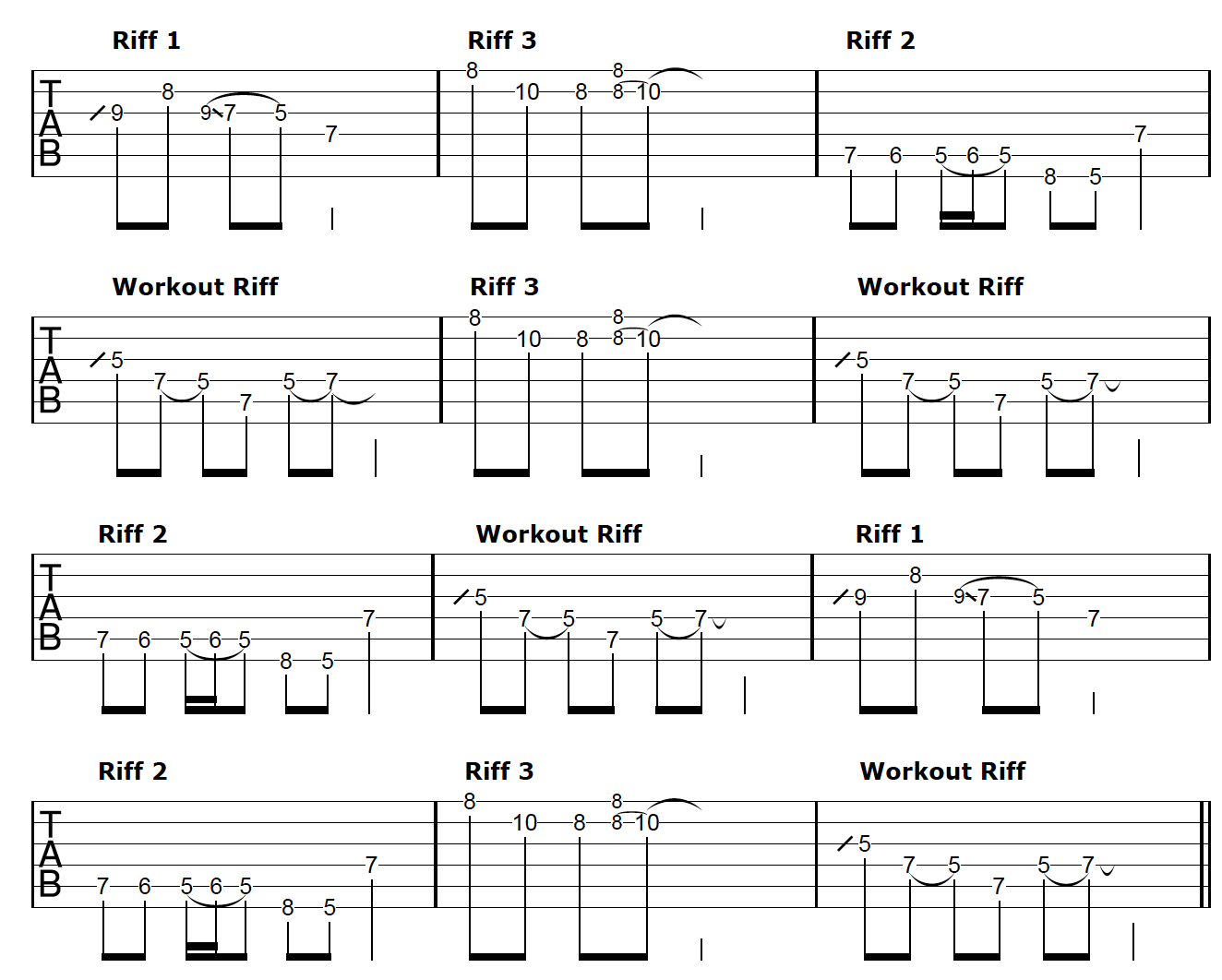
The idea in the example above is to connect in and out of the riff with the other 3 riffs. It’s like you are introducing the new riff to the other riffs you already know.
When you listen to the example above you will notice there is no gap between each riff as I play it. Once I finish one riff I immediately start playing the next one.
Musically this sounds awkward at best. However, we are not trying to be musical here at all. This is a training drill to easily and effortlessly connect your riff to your guitar playing. Giving yourself no time to do so helps train the brain to quickly make the connection.
So there you have it, the 7 step guitar riff workout.
Here is a summary for you:
1. Learning The Riff
2. Applying The Riff
3. Connect The Riff
4. Move The Riff
5. Pitch The Riff
6. Vary The Riff
7. Integrating The Riff
Discover more ways to create great sounding guitar solos using arpeggios
The 7 Step Guitar Riff Workout Part 1 - How To Improve Your Guitar Solo And Improvisational Skills
by Simon Candy
 Have you ever spent countless hours learning guitar riffs of your favourite players, only to feel frustrated when you couldn't replicate them in your own solos?
Have you ever spent countless hours learning guitar riffs of your favourite players, only to feel frustrated when you couldn't replicate them in your own solos?
Have you ever watched someone effortlessly improvise on the guitar and wished you could do the same?
Have you attempted to write or improvise guitar solos but struggled to make it sound good?
At various points in my time of learning and playing guitar, the answers to these questions were a big and very frustrating YES!
When I played guitar solos, they never sounded as good as the solos played by my favourite guitarists. They just sounded like I was repeating the same riffs I had learned and lacked the creativity and musicality of my favourite players.
At the time, I didn't know that there are additional steps to take if you want to truly integrate the riffs you've learned into your guitar playing. It's not enough to simply remember them; you should also be able to create variations of the riff and improvise off of it when soloing in real time.
The following are the first 3 steps of a 7 step guitar riff workout I have designed for you, that will get any riff you like into your guitar playing in a meaningful and musical way, for good.
The remaining 4 steps of the workout will follow in the 7 step guitar riff workout part 2 article lesson
Going through this guitar riff workout below will also develop and improve other crucial areas of your guitar playing including:
• Aural Skills (Ear)
• Fretboard Knowledge (visualising scales, arpeggios, chord shapes etc)
• Overall Improvisation And Soloing/Phrasing Skills
If you want to play guitar like your heroes, solo effortlessly using their riffs, and truly enjoy the process, then keep reading.
The 7 Step Guitar Riff Workout
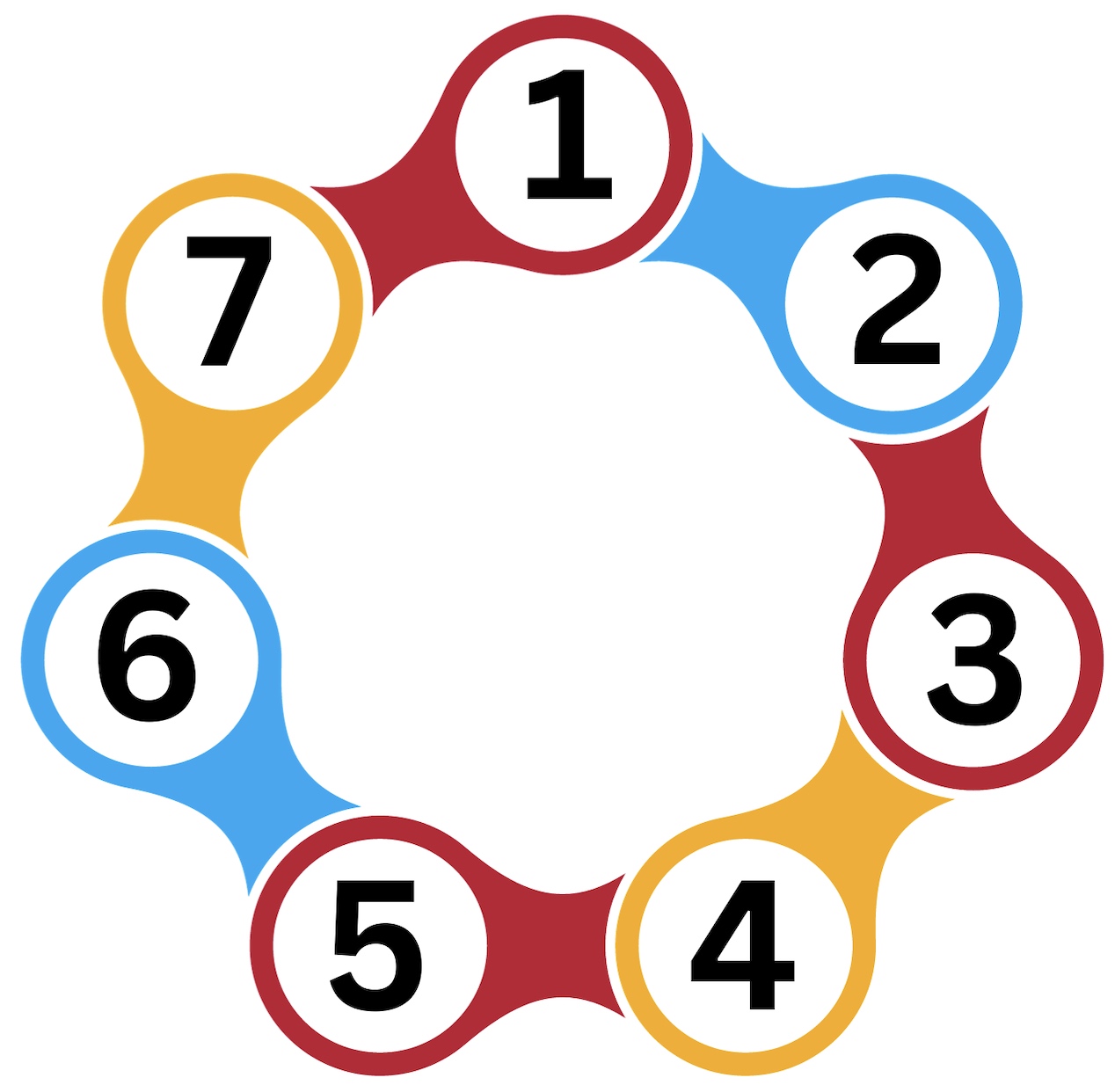 Simply learning a riff in isolation won't make it a part of your guitar playing. Just like learning a phrase in another language won't make you fluent in that language.
Simply learning a riff in isolation won't make it a part of your guitar playing. Just like learning a phrase in another language won't make you fluent in that language.
To truly master a riff, you need to put it into different contexts and gain the ability to create awesome music with it. This workout is designed to help you use the riffs you learn effortlessly in your guitar playing and to improve your guitar solo and improvisation skills every time you take a riff through this workout.
For today's lesson, I am going to use a very simple riff. I want you to stay focused on the process, not so much on the riff.
Once familiar with the workout you can take more involved riffs through it.
1. Learn The Riff
The first step of our workout is kind of obvious but important.
Here is the riff we will be using today:

Spend time getting this riff onto your guitar and into your fingers, although it shouldn’t take you long as it is short and simple.
2. Apply The Riff
Once you have the riff in your fingers it’s time to apply it to a musical context. This helps you hear the potential of how the riff can sound and is great for training your ears too.
Here is our riff over a chord progression in A Minor:
The basic idea is to play the riff over the chord progression and see how it sounds. Once you have tried this, you can start to improvise with the riff if you wish. With practice, you will become more comfortable with improvisation and be able to do it more often.
However, only applying a single riff in one way is a huge waste!
This is because a single riff will work and can be played in more than one musical context.
Great players don’t focus on learning many riffs. Rather, great players focus on applying a few riffs in many different ways.
THIS is how to have your riffs multiply, instantly.
For example, listen to our riff played over a chord progression in C Major:
How about the same riff now played over a 12 Bar Blues in A:
On the surface you thought you only had one riff when in fact you have at least 3! There are more ways you could apply this riff, multiplying it again, however it’s beyond the scope of this article to go any further here. Just know for now that applying the riffs you learn musically is important to do, and that there is always more than one way to do this.
To learn how to improvise on guitar, watch the video below. You will learn how to use scales, as well as other methods for improvisation.
3. Connect The Riff
A great way to get a riff into your playing so you can connect to it easily, as well as create variations of it is to:
1. Know the scale/key the riff comes from
2. Connect the riff to the specific scale shape it is coming from on the fretboard of your guitar
The first point above is to simply know the type of scale the riff comes from and the key.
Our riff above comes from a pentatonic scale.
They key is Am.
The second point is all about connecting the riff to the specific Am pentatonic scale it is coming from on the fretboard.
In this case our riff is derived from Pattern 1 Pentatonic Scale in Am starting from the 5th fret/6th string:
Pattern 1 Pentatonic Scale here
Knowing this is not enough though. We must be able to smoothly connect in and out of the riff from this scale effortlessly.
Here is an extremely effective drill doing just that:

In the drill above I am simply ascending up the first pattern of the pentatonic scale.
When I arrive at the first note of the riff, I divert from ascending the scale and play the riff.
Once I have completed playing the riff, I continue ascending the scale from the last note of the riff until I reach the top note of the scale.
It is the same when descending the scale:

Above I descend the scale until I reach the first note of the riff. When I do, I once again divert from descending the scale, and play the riff.
Once I have completed playing the riff, I continue descending the scale from the last note of the riff until I reach the bottom note of the scale.
This drill helps give you context to the riff regarding how it fits in the current position on the fretboard. It makes it easy for you to create variations as you will be aware of notes around that can be used in the riff. This is something we will be doing in part 2 of this article.
A variation of this drill is to play the riff first and then continue ascending the scale from the last note of the riff like so:

And then play the riff again, this time descending the scale from the last note of the riff:

You are creating points of connection regarding getting in and out of the riff. So when improvising within pentatonic scale pattern 1 you will be able to smoothly connect to the riff easily and effortlessly.
In part 2 of this article, I will take you through the remaining 4 steps of our guitar riff workout including:
• Creating variations of the riffs you learn, so one riff can become many
• Using riffs to open up the entire fretboard to you, enabling you to solo all over the neck of your guitar without limitation
• Getting the riffs you learn into your ear so you can create your own riffs quickly and easily, on the spot
For now, use the provided sample riff or create your own and complete the first 3 steps of the guitar riff workout.
For additional riff ideas, check out the video below. In it, you learn several double stop riffs that will bring a great sound to your soloing on guitar:
Learn how to create unique sounding solos on your guitar using open strings
How To Create Beautiful Sounding Chord Progressions On Guitar
by Simon Candy
This article is based on a concept covered in a previous lesson on creating beautiful music with simple chords.
I encourage you to check this lesson out, however, it is not necessary to understand and benefit from what is presented to you today.
With that said, we are now going to introduce a third chord, the D, to go with the E and A chords from the lesson linked above.
There are two reasons why I have chosen the D chord:
1. The A E and D chords all belong to the same key, A Major.
2. The D chord fits in with the strategy applied to the A and E chords previously regarding droning open strings
The video below will help reinforce and further train what was covered previously as well as what we cover in this lesson, so bookmark it to check out after working through what follows:
First, I am going to run you through the steps we did with the E chord previously, only with the D chord this time.
Step 1: D Chord Shapes
Here are the three D chord shapes we will be working with:

Here are the diagrams for each chord:
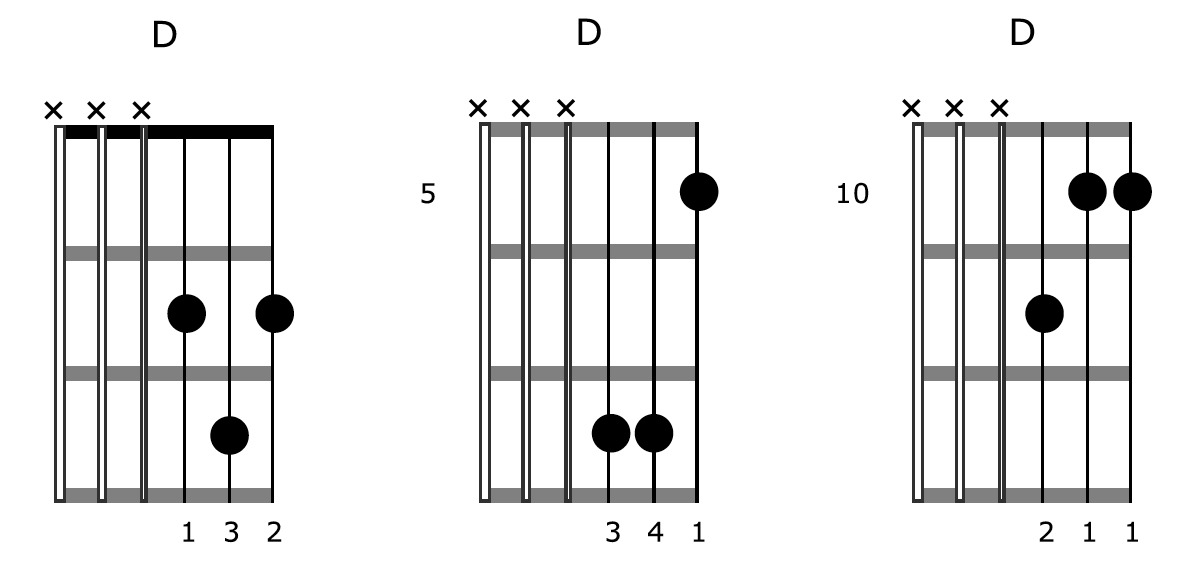
Step 2: Open Strings (High Drone)
Next, remove the finger that is on the first string of each chord to allow the open E note to ring throughout:

Here are the diagrams for each chord:
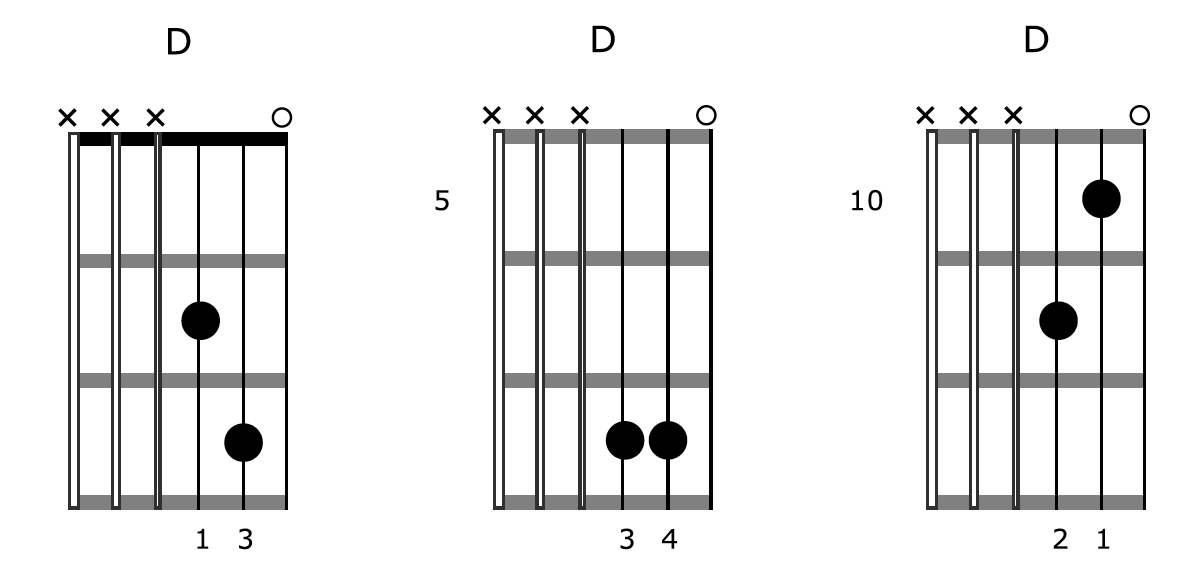
Step 3: Open Strings (Low Drone)
Let’s also add the open 4th string bringing a more full sound to our chords:

The open 4th string is a D note, the root note of our chord, so it works out well.
Here are the diagrams for each chord:
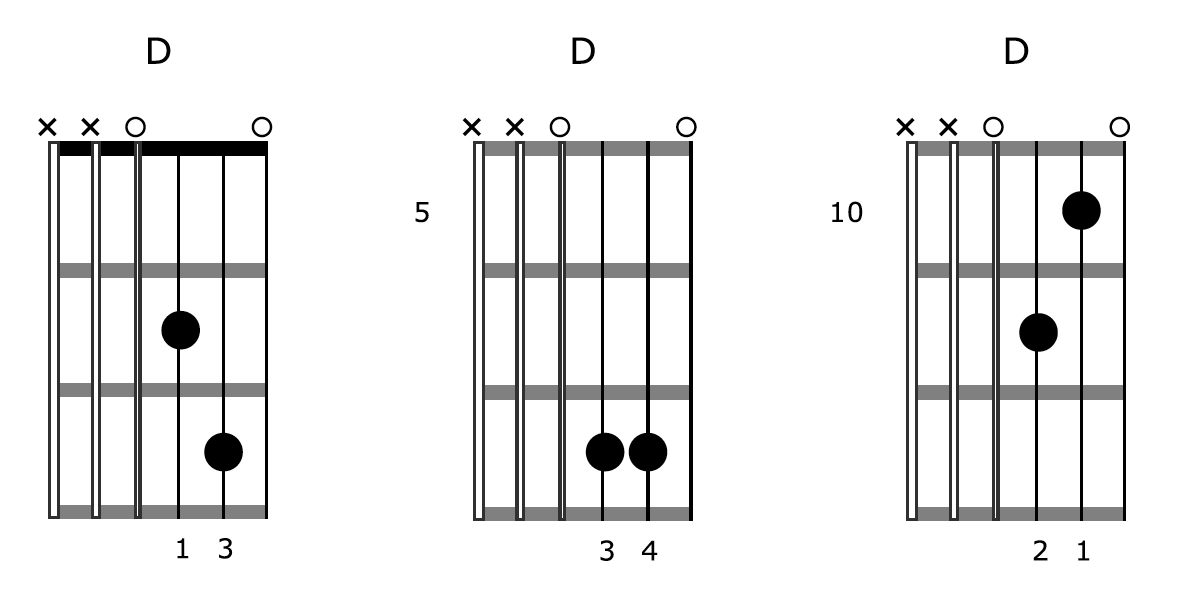
To become a little more familiar with the D chord shapes on your guitar, here is a drill that breaks up each shape as you run them up the fretboard:

Here is another drill, similar to the first, only picking each note separately within each chord shape:

Step 4: Adding Notes
Now, we are going to add notes to our D chord shapes.
Here are the more consonant notes you can add to each chord. Each of these notes belongs to the key and is why they sound more “in” to your ear for the most part:



Here is a mixture of consonant and distant sounds that can be included with the D chords. I am simply adding every possible note that falls within the position of each chord on the top string:



Remember all notes can work, in and out of key. It’s a matter of working with each sound and getting it in your ear that will determine how well you can get it to work within the context of the chord.
Step 5: Connecting Chord Shapes
To create music with each of our A, E, and D chords, we need to organise each of them by position on the fretboard. We did this with the A and E chords in the previous lesson, and will now simply add the corresponding D chord to each of those pairings like so:
• Chord Grouping 1

• Chord Grouping 2

• Chord Grouping 3
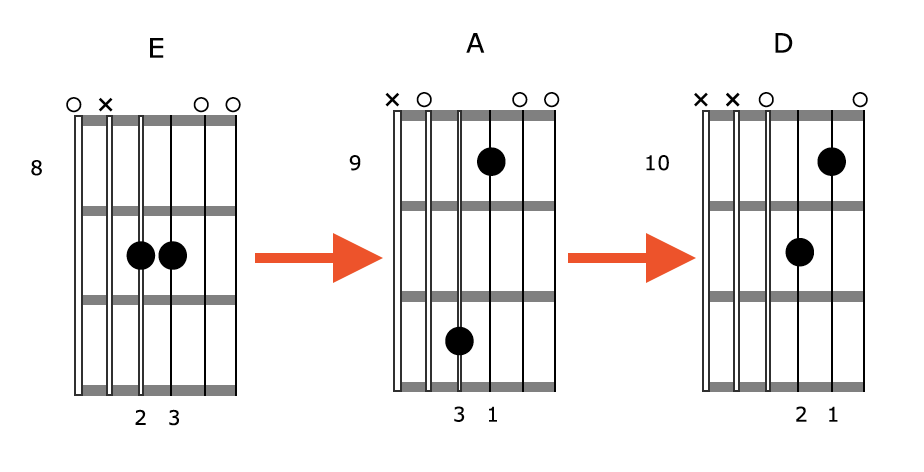
It is important to thoroughly learn the chord groups shown above. Being able to visualize the relationships between chords on the fretboard is crucial to having them easily accessible during guitar playing when there is no time to think.
Two Common Chord Progressions With A Difference
The following are two of the most common chord progressions you will play on your guitar, however, with a difference thanks to our creative chord strategy.
• A Major Chord Progression
Here is a typical chord progression in the key of A Major using our A, D, and E chords:
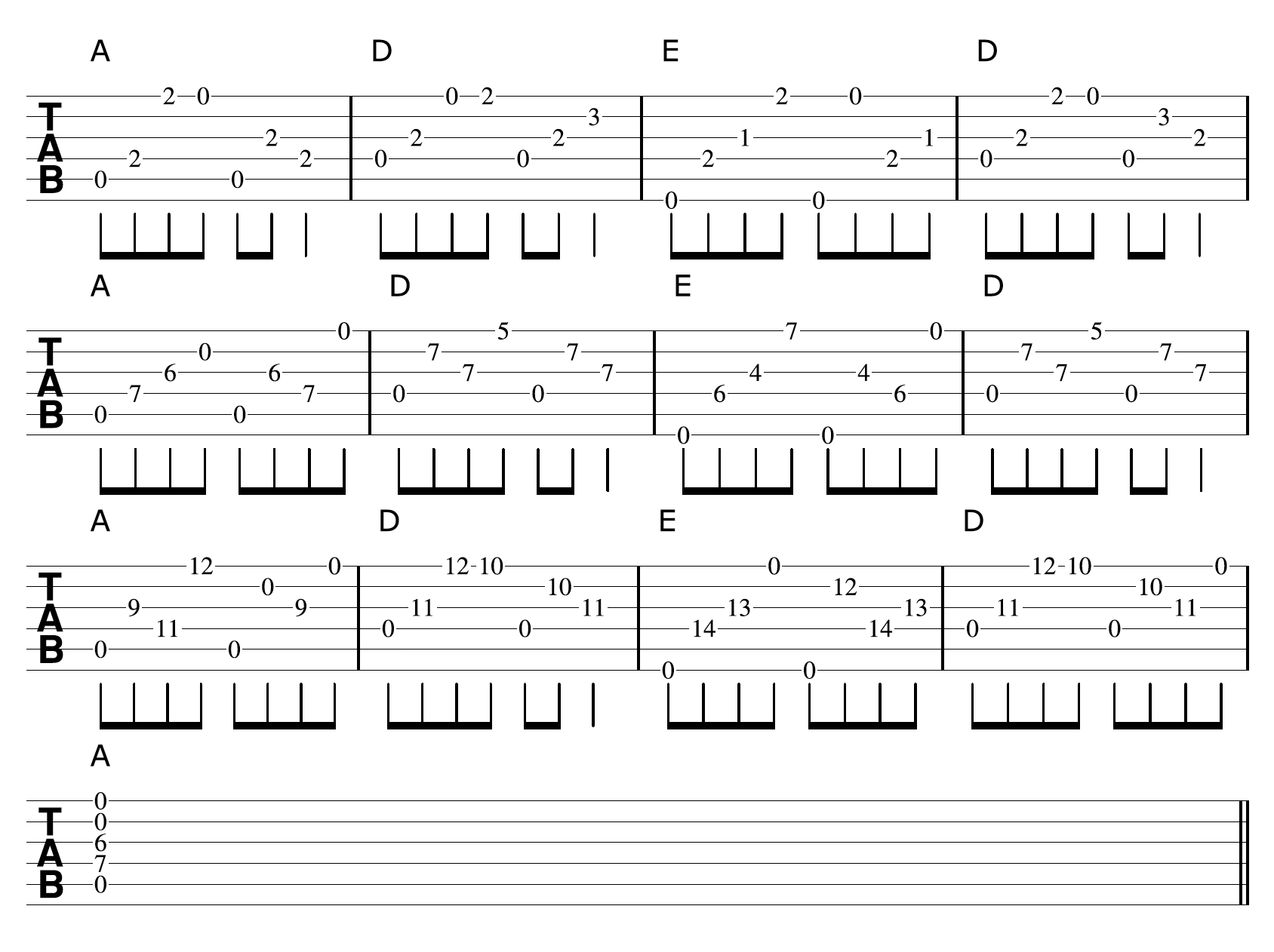
Each time I play through the progression above, I am moving up the fretboard to the next position to play each of these chords.
• A Blues Chord Progression
Here is a 12 bar blues progression in A using our A, D, and E chords:
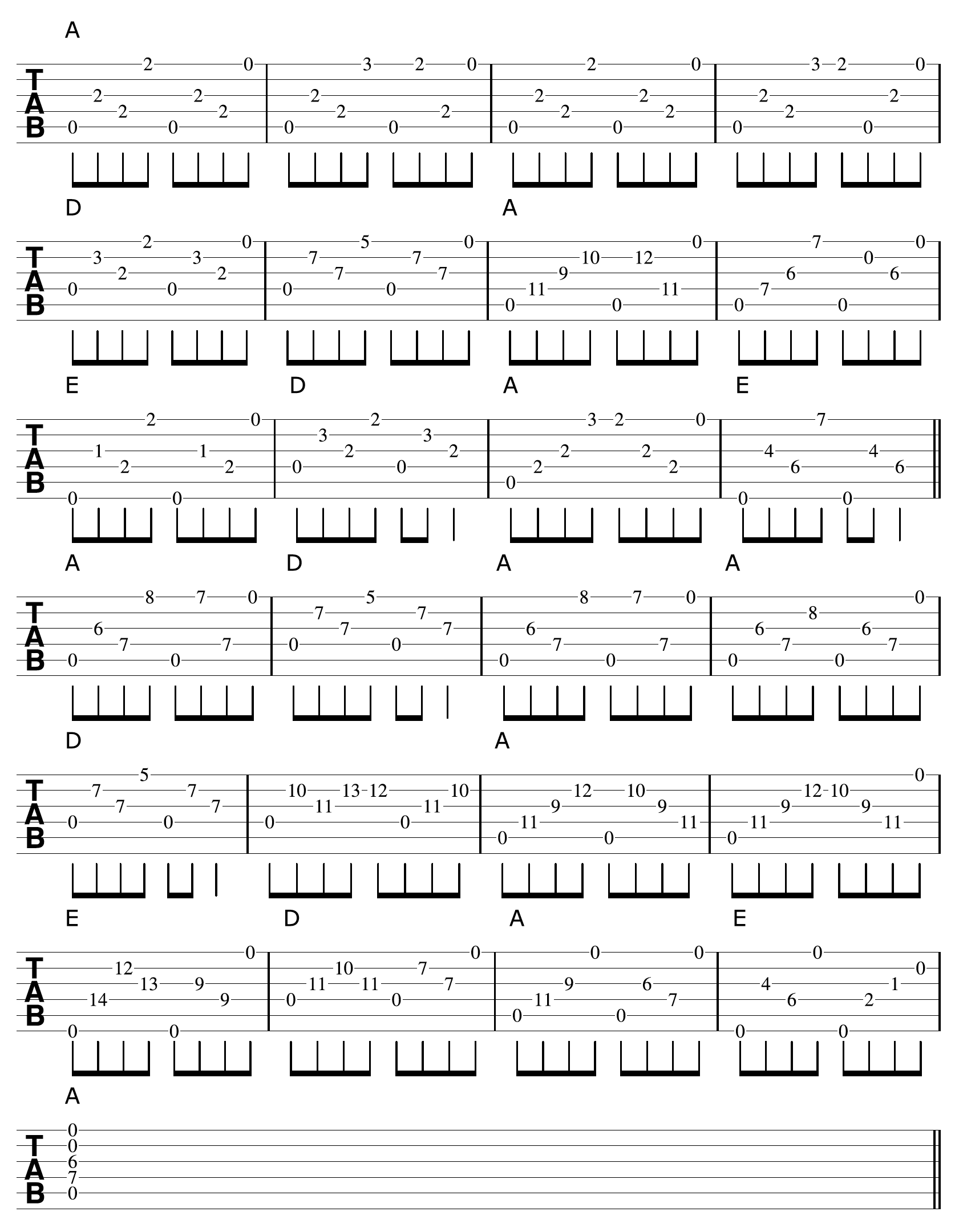
This progression consists of two 12 bar blues choruses in the key of A, utilizing various A, D, and E chord shapes from above:
Now you have the A, E, and D chords under your fingers, there are many progressions and songs you can apply them to.
Here are just a few to get you started:
• Jack And Diane - Jonh Cougar Mellencamp
• Satisfaction - The Rolling Stones
• I Saw Her Standing There - The Beatles
• Cocaine - J.J. Cale
• Lean On Me - Bill Withers
• Sweet Caroline - Neil Diamond
• Chasing Cars - Snow Patrol
• Born In The USA - Bruce Springsteen
• Walk On The Wildside - Lou Reed
• Johnny B Goode - Chuck Berry
These songs are composed entirely of A, D, and E chords, or they prominently feature these chords. You can use these songs and progressions to create different versions using the method taught in this article.
Discover more chord shapes to create beautiful sounding music on guitar